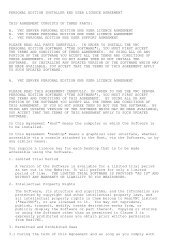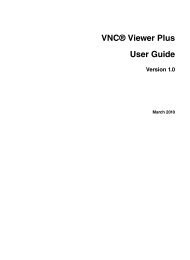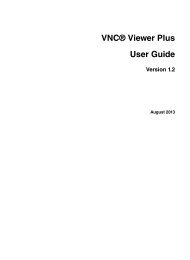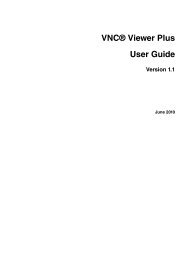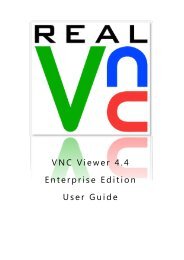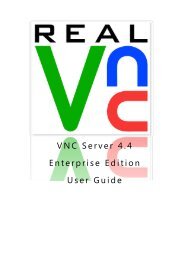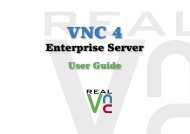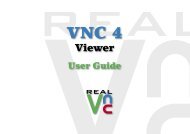VNC User Guide - RealVNC
VNC User Guide - RealVNC
VNC User Guide - RealVNC
You also want an ePaper? Increase the reach of your titles
YUMPU automatically turns print PDFs into web optimized ePapers that Google loves.
Chapter 7: Making Connections Secure<br />
Mac OS X<br />
Under Mac OS X, system authentication is selected using the Mac password option in the Authentication<br />
dropdown of the <strong>VNC</strong> Server - Options dialog. More on this dialog.<br />
This means, to connect to <strong>VNC</strong> Server:<br />
• In Service Mode, a user must supply the credentials of a member of the admin group.<br />
• In <strong>User</strong> Mode, a user must supply the credentials of the host computer user starting <strong>VNC</strong> Server.<br />
You can add different users or groups to the authentication list if you do not want to publish the credentials of<br />
host computer users with administrative privileges. For more information, see Managing users and groups in<br />
the authentication list on page 102.<br />
Note that the credentials supplied by a user in order to connect to <strong>VNC</strong> Server determine the <strong>VNC</strong><br />
permissions granted to that user. <strong>VNC</strong> permissions control which Real<strong>VNC</strong> remote control features the user<br />
is allowed to use. By default, a Full set of <strong>VNC</strong> permissions is granted. For more information on what this<br />
means, and how to revoke <strong>VNC</strong> permissions in order to restrict access to Real<strong>VNC</strong> remote control features,<br />
see Restricting features for particular connected users on page 114.<br />
Once connected to <strong>VNC</strong> Server:<br />
• In Service Mode, a user has the same privileges (that is, access rights) as the currently logged on host<br />
computer user. If no host computer user is logged on, then the user must log on to Mac OS X in order to<br />
continue.<br />
• In <strong>User</strong> Mode, a user has the same privileges as the host computer user starting <strong>VNC</strong> Server.<br />
In either case, this need not be a host computer user with administrative privileges even if the credentials of<br />
one were supplied in order to connect to <strong>VNC</strong> Server. The opposite also holds true: a connected user has<br />
administrative privileges on the host computer if such a user either started <strong>VNC</strong> Server (<strong>User</strong> Mode) or is<br />
currently logged on (Service Mode).<br />
<strong>VNC</strong> <strong>User</strong> <strong>Guide</strong> 101



